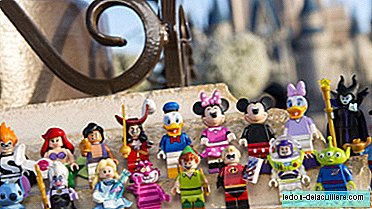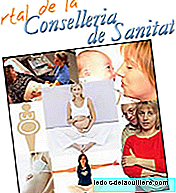
One of the most modern concerns that parents have about the education of our children is the quality of the food we give them. It is something relatively common since at other times they had enough to find something to eat. The improvement of the living conditions and the landing of the industry in the field, as well as the improvement of the conservation techniques made that the access to food as well as the variety of these improved considerably.
Over time all this has improved and today nobody is surprised to eat an Argentine veal in a restaurant on the shores of the Mediterranean or a pre-cooked dish that arrives from Vietnam. But all this brings its problems and it is that to maintain the state and the good aspect of the food they began to use different compounds, as well as to increase the production of raw material. Not everything turned out to be very healthy and many were affected by these practices. Nowadays things have changed and there is a multitude of analyzes, tests and controls for food to be safe, but there are still some who claim that there are still dangers and we as parents ask ourselves, Is what our children eat healthy?
In the case of my children, during breastfeeding it was my wife who worried about eating healthy, something that we do not always have in mind or at least we did not have before we became parents. Once we started to introduce complementary food, it was when I began to worry a little more about what products we consumed at home, it was not something exaggerated, we simply followed the basic recommendations and a little common sense when trying to maintain a balanced diet.
It was in my work environment, where I realized that people took their food and that of their children in a much more intense way. I saw how many people checked the composition labels of the food they bought, and even that they had stopped consuming certain foods because they contained substances that could be harmful, had appeared chemophobia in our environment.
A little experiment
We are going to do a little experiment, if you let me.
Would you buy something that carries this composition?
INGREDIENTS: water (75%), sugars (12%) (glucose (48%), fructose (40%), sucrose (2%), maltose (<1%)), starch (5%), fiber E460 (3%) , amino acids (glutamic acid (19%), Aspartic (16%), Histidine (11%), Leucine (7%), Lysine (5%), Phenylalanine (4%), Arginine (4%), Valine (4%) ), Alanine (4%), Sserine (4%), Glycine (3%), Threonine (3%), Isoleucine (3%), Proline (3%), Tryptophan (1%), Cystine (1%), Tyrosine (1%), Methionine (1%)), fatty acids (1%) (palmitic (30%), OMEGA-6 fatty acids: Linoleic acid (14%), OMEGA-3 fatty acid: Linolenic acid (8%), oleic (7%), palmitoleic (3%), stearic (2%), lauric acid (1%), myristic acid (1%), capric (<1%)), dry residue (<1%), phytosterols, E515, oxalic acid, E300, E306 (Tocopherol), phylloquinone, thiamine, COLORS (Yellow-orange E101 (riboflavin), yellow-brown color E160a), FLAVORS (3-methylbut-1-yl ethanoate, 2-methylbutyl ethanoate, 2-methyl-1-OL, 3-methyl-butyl-1-OL, 2-methyl hydroxy-3-methyl-butanoate, 3-methylbutanal, ethylhexanoate , ethyl butanoate, pentyl acetate), 1510, natural ripening agent (GAS ethylene).
Well I hope your answer was affirmative It is a very nutritious product, which helps your defenses (in winter and at any time) and with a great flavor. We talk about banana, which by the way is more effective in preventing colds than those famous products whose advertisement looks like an x-men chapter rather than a dairy product.
Even more scary is the composition of a simple chicken egg, those that are so good are fried and accompanied by a little sausage.

INGREDIENTS : AQUA (75.8%), amino acids (12.6%) (glutamic acid (14%), aspartic acid (11%), valine (9%), arginine (8%), leucine (8%), lysine (7%), serine (7%), phenylalanine (6%), alanine (5%), Isoleucine (5%), proline (4%), tyrosine (3%), threonine (3%), glycine (3 %), histidine (2%), methionine (3%), cystine (2%), Tryptophan (1%)); FATTY ACIDS (9.9%) (octadecenoic acid (45%), Hexadecanoic acid (32%), octadecanoic acid (12%), Eicosatetraenoic acid (3%), eicosanoic acid (2%), docosanoic acid (1%), tetracosanoic acid (1%), octanoic acid (<1%), Decanoic acid (<1%), dodecanoic acid (<1%), tetradecanoic acid (<1%), pentadecanoic acid (<1%), heptadecanoic acid (<1%) , Tetradecenoic acid (<1%), hexadecenoic acid (<1%), Eicosenoic acid (<1%), docosenoic acid (<1%), omega-6 fatty acid: octadecadienoic acid (12%), OMEGA-3 fatty acid : Octadecatrienoic acid (<1%), eicosapentaenoic acid (EPA) (<1%), OMEGA-3 fatty acid: DOCOSAHEXAENOIC acid (DHA) (<1%)); Sugars (0.8%): (glucose (30%), sucrose (15%), fructose (15%), Lactose (15%), maltose (15%), galactose (15%)); COLORS (E160c, E160), E306, E101; FLAVORS (phenylacetaldehyde, dodeca-2-ENAL, hepta-2-enal, hexadecanal, octadecanal, pentan-2-ONA, Butan-2-ONA, acetaldehyde, formaldehyde, acetone ); SHELL (E170), ALSO CONTAINS Benzene and Benzene Derivatives, esters, furans, sulfur-containing compounds and terpenes.
I guess if we had to label each egg with everything it contains, a dozen of them would occupy the same as a pack of soda cans, or maybe we would have to sell them with a magnifying glass to see its ingredients (now that I think about it, does that does it happen now?)
Seen this way, we might not buy these products so lightly, which it would be a tremendous mistake They are basic foods in a balanced diet. But when they talk to us in chemical terms, it seems that everything is less reliable and strange, less "homemade." And our brain, which for that little has evolved since we gave the mammoth steak, associates the unknown with the dangerous and thus heals in health.
One thing must be clear and that is that the sanitary controls to which food products are subjected today are allowing us to extend our existence, together of course, to other factors.
Where do I want to go?
These days, well, who says days could say years, we are seeing a confrontation between two sides, to call it somehow. On the one hand we have one new trend, the call "ecological" or the one formed by those products labeled by the already archifamous syllable "BIO" and on the other they are still the big multinationals with their lifelong products, with its preservatives, dyes and flavor enhancers.
And who are the good guys? Well, from my humble opinion none. Neither are as bad as they are painted, nor do others have as many virtues as they advertise or at least as many as to justify their exorbitant prices. They will not poison us, at least in most cases, nor will they make us live 200 years. And it is what he has to live, that kills (although it seems silly to say it) and for the moment we have no fix (though, we have a few patches).
But here you have our children and their food. After this appetizer and in future entries, I will try to bring some light on various aspects related to the feeding of our children.












